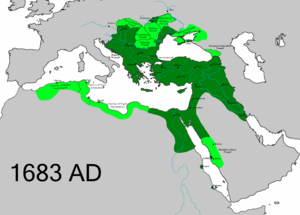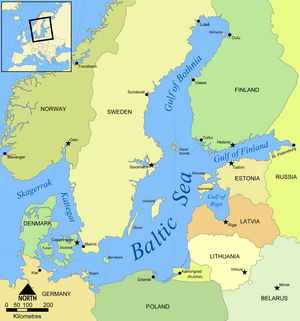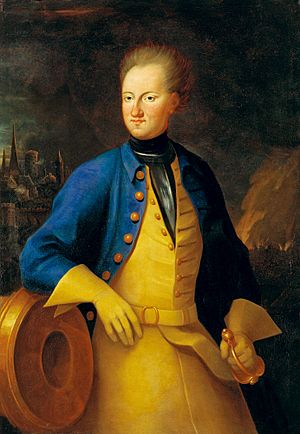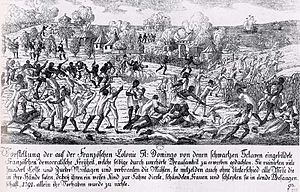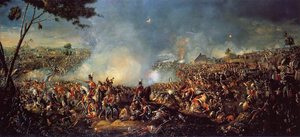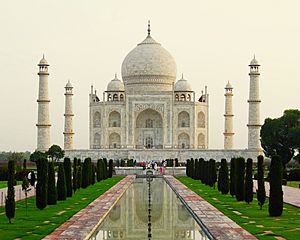International relations (1648–1814) facts for kids
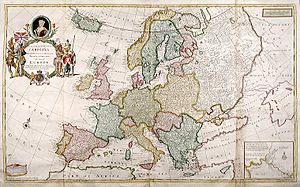
This article is about how countries interacted from 1648 to 1814. It covers a time when Europe saw many changes. Nations dealt with each other through talking (diplomacy), fighting wars, people moving around, and sharing cultures. This period started after the Peace of Westphalia treaty and ended with the Congress of Vienna.
Contents
- How Europe Changed
- Talking and Fighting Among Nations
- France and the "Second Hundred Years' War"
- Europe: 1648–1721 Power Shifts
- Europe: 1715–1789 A Time of Change
- China
- India
- See also
How Europe Changed
Balance of Power in Europe
During this time, countries tried to keep a "balance of power." This meant no single country or group of countries should become too strong. If one nation grew too powerful, others would team up to stop it. This often led to alliances, changes in borders, and military actions.
New Ways of Diplomacy
Formal ways of talking between countries and making treaties became more common. Big agreements like the Peace of Westphalia (1648) and the Peace of Utrecht (1713) redrew maps. They also recognized that countries had their own right to rule themselves. This shaped how diplomacy worked.
Colonies and Empires Grow
European countries expanded their empires all over the world. This led to rivalries over resources, trade routes, and land. These fights often caused wars, like the Seven Years' War (1756-1763).
Wars Over Rulers and Land
Many wars happened because of who would rule next or who owned certain lands. Wars like the War of Spanish Succession (1701-1714) and the Napoleonic Wars (1799-1815) changed Europe's borders and power. Their effects were felt far beyond Europe.
Britain and France Rule the Seas
Naval power became very important. The British Royal Navy and the French Navy became the strongest. They could project their power far away. This helped them control trade routes and expand their colonies overseas.
Money and Trade Drive Decisions
Money and trade were big reasons for international relations. Countries wanted to expand their trade and protect their businesses. This influenced diplomacy, wars, and alliances. Nations always tried to grow their wealth and power.
Revolutions Change Everything
The Age of Enlightenment brought new ideas about freedom and rights. Then came big revolutions like the American Revolution (1775-1783) and the French Revolution (1789-1799). These events challenged old systems of kings and nobles. They inspired other movements and changed the way countries interacted.
Talking and Fighting Among Nations
The 1600s were not peaceful in Europe. Major wars happened almost every year. These wars were often very harsh. The Thirty Years' War (1618–1648) especially hurt civilians in Germany. Many people died, and the economy was ruined.
The Peace of Westphalia (1648) ended the Thirty Years' War. Before this, religion often caused wars. After Westphalia, countries focused more on their own power and land. The Catholic Church, for example, turned its attention to missions overseas instead of fighting Protestants in Europe. Countries started to act based on what was best for them, often trying to create a "balance of power."
Before 1700, diplomacy was not very good. Countries often missed chances to avoid wars. For example, King Charles II of England didn't pay much attention to diplomacy. During a war with the Dutch, England had no diplomats in Denmark or Sweden. When Charles needed them as allies, his special messengers made mistakes. They didn't know much about the local politics or people.
France set the standard for new, professional diplomacy. Other countries soon copied them. French became the language used by diplomats. This new system had full-time professionals, clear rules, and good pay. Experts were valued, but noble status still helped. These new offices kept careful records. They became known for their good work in dealing with other countries. King Louis XIV of France worked hard to create the best diplomatic service. He had permanent ambassadors in many capitals. Diplomacy became a popular career for rich nobles.
By 1700, Britain and the Netherlands had small armies but strong navies and lots of money. They used smart diplomacy to build alliances. They paid other countries to fight on their side. They even hired soldiers from smaller German states. Peace conferences like those at Utrecht (1713) and Paris (1763) were like a game. Diplomats traded war victories for pieces of land, without caring about the people living there.
France and the "Second Hundred Years' War"
In 1648, France was the strongest country in Europe. It had a large population, lots of wealth, a central location, and a very strong army. It had mostly avoided the damage of the Thirty Years' War. But France had problems too. Its money system was not good, making it hard to pay for wars. Also, other countries often teamed up against it.
King Louis XIV ruled for a very long time. France fought three big wars during his reign: the Franco-Dutch War, the Nine Years' War, and the War of the Spanish Succession. Louis loved war and saw it as a way to gain glory. He told his diplomats that their job was to help the French military. By 1695, France was still strong, but England and Holland together controlled the seas. Many countries, both Protestant and Catholic, were allied against France.
Vauban, a top French military expert, warned the king in 1689. He said that the enemy alliance was too strong at sea. He suggested that France should let its merchant ships become "privateers." These privateers would attack and capture enemy merchant ships. This would be cheaper and safer than fighting big naval battles. Vauban believed this would force France's enemies to make peace.
Europe: 1648–1721 Power Shifts
The late 1600s saw big changes in Europe. Wars were still the main force shaping things. France was powerful at first, but it lost some of its strength in a series of big wars. These included the Nine Years' War, the War of the Spanish Succession, and the Great Northern War.
By 1700, four main powers stood out: England, France, Russia, and the Habsburg Monarchy (Austria). Prussia was also becoming strong due to its leaders and military. Other countries like Spain, Portugal, the Netherlands, and Sweden were losing power. England, despite its own civil war, grew stronger internationally. Its Royal Navy became the best on the oceans. As an island, England could keep its army small. It used its money to support allies and keep a balance of power in Europe.
Spies and Secrets
The 1700s saw a big increase in spying. Wars were common, and armies grew much larger. Foreign ministries also became bigger and more complex. Countries set up intelligence departments with full-time staff and paid spies. Military officers were sent to embassies abroad to gather information. France, under King Louis XIV, had a well-organized spy system. France and England even opened and read foreign mail.
Countries and Their Armies
Here's a look at how big some European countries and their armies were around 1690:
| Main European countries | Population about 1648 | Army about 1690 |
|---|---|---|
| France | 15 Million | 130 Thousand |
| Holy Roman Empire (Austria) | 8 Million | 50 Thousand |
| Brandenburg-Prussia | 1.4 Million | 25 Thousand |
| Italian states | 12 Million | Unknown |
| Low Countries | 3.5 Million | 73 Thousand (Netherlands) |
| British Isles | 7.5 Million | 80 Thousand (England) |
| Scandinavia | 2.5 Million | 90 Thousand (Sweden) |
This table shows that France had the largest population and army.
The Dutch Republic's Rise and Fall
In 1648, the Eighty Years War ended, and the Dutch Republic became independent from Spain. The Dutch were a major naval power. They controlled sea trade with Asia, the Americas, and within Europe. This led to conflicts with England and France, who were also growing their empires.
Three Anglo-Dutch Wars were fought from 1652 to 1674, mostly at sea. In 1672, Louis XIV invaded the Netherlands. He almost won, but the Dutch flooded their land to slow him down. Spain, Brandenburg-Prussia, and Austria joined the Dutch side. England eventually made peace and joined the alliance against France. The war ended with small gains for France. After the Glorious Revolution, when the Dutch leader William of Orange became King of England, power slowly shifted from Amsterdam to London.
The Great Turkish War: 1683–1699
This war was between the Ottoman Empire and a group of European countries called the Holy League. The League included the Pope, the Holy Roman Empire (Austria), Poland, and Venice. Russia joined in 1686. The fighting began in 1683 when the Ottomans tried to capture Vienna. They were defeated and forced to retreat. The war ended in 1699 with the Treaty of Karlowitz. The Ottoman Empire lost a lot of land for the first time. This war also marked Russia's first time joining a Western European alliance.
British Policy Under William III (1689–1702)
William III controlled Britain's foreign policy very closely. He became king of England in 1688 to stop King James II from bringing back Catholicism. But William's main goal was to stop King Louis XIV of France from expanding France's power. He wanted to build alliances against France and protect the Netherlands.
England and France were at war almost constantly until 1713. The combined English and Dutch navies were stronger than France's at sea, but France was stronger on land. William allied with Leopold I, the Habsburg Emperor, to balance France's land power. William was a smart strategist across Europe.
The English leaders usually supported William because they saw France as their biggest enemy. But the wars were very expensive. The Bank of England was created in 1694. It helped finance the wars by making it easier for bankers to lend money to the government.
Nine Years' War: 1688–1697
The Nine Years' War was a big conflict between France and a large European alliance. This alliance included Austria, the Holy Roman Empire, the Dutch Republic, Spain, Britain, and Savoy. It was fought in Europe, at sea, in Ireland, North America, and India. Some people call it the first truly global war.
Louis XIV was the most powerful ruler in Europe after the Franco-Dutch War in 1678. He tried to expand France's borders. But his actions, like taking back rights from Protestants in 1685, weakened his power. When Louis invaded the Rhine area in 1688, Leopold I and the German princes resisted. Then the Dutch and English joined the war against France. Louis finally faced a strong group of countries trying to stop him.
William III of England became the main leader of this alliance. He was the key person in planning the alliance's military and diplomatic moves. William's main plan was to create an alliance of England, the Netherlands, the Holy Roman Empire, Spain, and smaller states. They would attack France from different directions and defend the Netherlands. Louis XIV tried to weaken this by supporting others who claimed the English throne. The wars were very expensive for both sides but didn't have a clear winner.
The main fighting happened around France's borders. Louis XIV's armies often won battles, but by 1696, France was in an economic crisis. The English and Dutch were also tired of the war. All sides wanted peace. The Peace of Ryswick (1697) allowed Louis XIV to keep some land. But he had to give back other areas and accept William III as the rightful King of England. The Dutch also got a system of forts in the Spanish Netherlands to protect their borders. However, a new war was coming soon over who would inherit the Spanish Empire.
Great Northern War: 1700–1721
From 1560 to 1660, Sweden had taken a lot of land in the Baltic region from Denmark and Poland.
In 1700, Denmark, Poland, and Russia declared war on Sweden. Denmark was quickly forced to make peace. King Charles XII of Sweden then defeated the Russian army in the Battle of Narva. Charles then went into Poland to remove the Polish king. He succeeded in 1706.
Meanwhile, Russia had captured several towns by the Baltic Sea. Charles decided to march directly on Moscow. But extreme cold, supply problems, and Russia's "scorched earth" strategy forced him to turn towards Ukraine. He had lost most of his soldiers. In 1709, Charles faced the modernized Russian army under Tsar Peter the Great at the Battle of Poltava. Russia won a huge victory. Charles escaped to the Ottoman Empire for six years. After Poltava, Poland and Denmark rejoined the war. Sweden lost control of the eastern Baltic and never regained its former power. Russia gained access to the Baltic Sea and became a major European power.
Russia's Rise
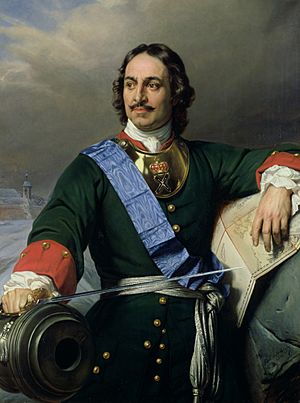
In Russia, the tsar made all the main decisions. This led to strong policies under powerful leaders like Peter the Great and Catherine the Great. But when there were weak tsars, like children with a regent, things could be unpredictable.
Russia's main goal was to expand its territory through wars and treaties. They wanted land, warm water ports, and to protect Orthodox Christianity. Their main tool was a very large and improving army.
To the northwest, Russia fought Sweden for control of the Baltic Sea for a century. Peter the Great modernized Russia's government and military like Western countries. Russia won by the 1720s, gaining access to the sea and control of Finland and the Baltic states. To the west, Russia fought Poland and Lithuania. Later, agreements with Prussia and Austria gave Russia most of Ukraine and a large part of Poland.
In 1812, Napoleon invaded Russia but was defeated. Russia then played a key role in defeating Napoleon. It became a strong, conservative voice in Europe from 1814 to the 1840s.
The War of the Spanish Succession: 1702–1714
Spain had many important lands in Europe, like the Spanish Netherlands (now Belgium) and parts of Italy. It also had a huge empire overseas, including much of the Americas and the Philippines. These colonies provided a lot of silver.
But Spain had many weaknesses. Its economy was poor, with little industry. It had to import most of its weapons. Its army was large but poorly trained. Its navy was surprisingly small. The central government was weak. King Charles II ruled from 1665 to 1700, but he was very sick.
King Charles II had no children. The question of who would be the next king of Spain led to a major war. The Habsburg family (from Austria) had a candidate. The Bourbon family (from France) also had a candidate: the grandson of King Louis XIV. Spain's silver and its inability to protect its lands made it a target.
Charles II made a bad decision. In his will, he named the Bourbon candidate, a Frenchman, as his heir. This person became Philip V of Spain. France supported this choice. But a group of enemies quickly formed an alliance, and a major European war began from 1701 to 1714. France gaining control of Spain and its vast empire was unacceptable to France's rivals. Also, the idea of dividing up Spain's lands was very appealing.
France's enemies formed a Grand Alliance. It was led by the Holy Roman Emperor Leopold I. It included Prussia, most German states, the Netherlands, Portugal, Savoy (in Italy), and especially England. France controlled Spanish forces and had allies in Bavaria and some Italian and German dukes.
Much fighting happened in the Netherlands. When Emperor Leopold died, his son Joseph took over. But when Joseph died in 1711, his brother Charles became both the Alliance's candidate for King of Spain and the Emperor. This would make the Empire too powerful. So, the allies left the alliance, and peace talks began.
The Peace of Utrecht in 1713 solved all the issues. Philip V became king of Spain and kept all his overseas colonies. But he gave up any claim to the French throne. Spain lost its European lands outside of Spain itself. The former allies gained spoils. England got Newfoundland, Nova Scotia, and Gibraltar, plus trading rights in Spanish colonies. Spain now had a new Bourbon government, which was much more effective than the old one.
Europe: 1715–1789 A Time of Change
Peaceful Years: 1715–1740
The 25 years after the Peace of Utrecht were mostly peaceful. There were no major wars, only a few small military events. For example, the War of Jenkins' Ear was a small naval war between Britain and Spain over British smuggling. It started in 1739 and was fought in the Caribbean. The fighting ended with no real gains for either side.
The main powers were tired from all the wars. Many people had died, and navies were ruined. Countries had high debts and taxes. The Utrecht treaty helped create a time of stability in Europe. It was based on the idea of a balance of power, meaning no one country would become too strong. Robert Walpole, Britain's main leader, wanted peace because it was good for trade and the growing British Empire.
Britain played a key role in keeping this balance. Its goals were to maintain peace for trade and to strengthen its own position. Britain often allied with the Netherlands and Prussia, and paid them to support their armies. These wars involved all of Europe and the colonies overseas. They happened every decade starting in the 1740s and ended with Napoleon's defeat in 1814.
Louis XV's Reign
Unlike the very active Louis XIV, his grandson Louis XV was not very interested in diplomacy or wars during his long rule (1722-1774). France's main foreign policy leader was Cardinal Fleury. He knew France needed to rebuild, so he aimed for peace. France had a poor tax system, and the government was always short on money.
War of the Quadruple Alliance (1718–1720)
One of the few military events was the War of the Quadruple Alliance. Austria and the new Bourbon King of Spain, Philip V, argued over Austria's control of Italy. Philip V wanted to get back parts of Italy that Spain had lost. Spanish fleets captured Sicily and Sardinia. An alliance of Britain, France, Austria, the Dutch Republic, and Savoy formed to restore the balance of power. Naval victories by this alliance forced Spain to back down.
War of the Austrian Succession (1740–1748)

This war ended the peaceful time. It was about Maria Theresa's right to become ruler of Austria after her father died. But in reality, France and German rivals like Prussia and Bavaria saw a chance to challenge Austria's power. Maria Theresa was supported by Britain, the Dutch Republic, and Hanover. The war grew to include Spain, Sardinia, Saxony, Sweden, and Russia.
The war ended in 1748 with the Treaty of Aix-la-Chapelle. There were very few changes to borders. Maria Theresa's right to rule was accepted. But Austria had to recognize Prussia's control of Silesia. The main result was that Prussia became a growing international power. Also, Austria later allied with France, ending their long rivalry. This pushed England into an alliance with Prussia to continue stopping France.
Britain: A Nation of Traders
Most major powers wanted more land and to protect their royal families. But Britain had a different main goal: building a worldwide trading network. This needed a very strong Royal Navy to protect its ships and prevent invasions. The British government helped private companies set up trading posts and businesses around the world. Each company had a monopoly on English trade to a specific region. Famous ones included the East India Company and the Hudson's Bay Company.
Britain's involvement in the four major wars from 1740 to 1783 paid off well for trade. Even losing the Thirteen Colonies was balanced by good trade with the new United States. Britain gained control of trade with India and dominated the profitable slave, sugar, and commercial trades from West Africa and the West Indies.
London's financial system was very good at funding not only British forces but also its allies. The government borrowed a lot of money to pay for wars. By 1714, the national debt was high, but a system was in place to pay it off. King George I focused on Hanoverian affairs. Sir Robert Walpole was the main decision-maker from 1722 to 1740. He wanted peace and signed an alliance with France. The Netherlands, much weaker, followed Britain's lead.
Seven Years' War
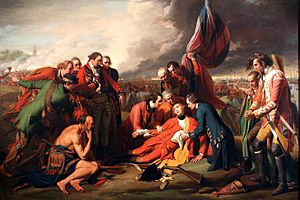
King Louis XV of France is known for losing badly in the worldwide Seven Years' War. In 1763, France lost New France in North America to Spain and Great Britain. Most experts believe Louis XV's decisions hurt France's power, weakened its money, and made the monarchy unpopular. This set the stage for the French Revolution 15 years after his death.
American War for Independence
After winning the Seven Years' War, Britain decided to control its fast-growing American colonies more tightly. The colonies had 2.5 million people, compared to Britain's 6 million. In 1765, Britain started imposing taxes without the colonies' consent. These taxes were small, but the principle was important. Americans said it violated their rights as Englishmen. They demanded "No taxation without representation."
After years of disagreement, American patriots destroyed British tea in Boston Harbor in 1773 (the Boston Tea Party). London responded with harsh punishments. The colonies united and formed a Continental Congress. Boycotts hurt British merchants. London sent more troops, and colonists trained their militias. Fighting began in 1775. American Patriots took control of the Thirteen Colonies. The king refused to compromise. An American Army, led by General George Washington, forced the British out of Boston. On July 4, 1776, the Declaration of Independence was adopted, declaring the United States independent.
Benjamin Franklin, the main American diplomat in Paris, was very popular in France. France wanted revenge after its defeat in the 1760s. It secretly funded the American revolt. After Americans captured a British army at Saratoga in 1777, France officially declared war on Britain. The Dutch and Spanish also joined the fight. Britain had no major allies but hired German soldiers. The Royal Navy was outnumbered.
The British had some success in the southern United States. But a combined French-American army captured another British army at Yorktown in 1781. The French Navy also drove off a British rescue fleet. The United States was now truly independent. Britain offered good peace terms to ensure future trade. The naval war continued, with Britain gaining against the French Navy and protecting Gibraltar. After losing the American colonies, Britain focused on India and Asia, where it gained much. For France, the war was very negative. Its heavy spending in the Seven Years' War and the American Revolutionary War bankrupted the French government. This led to the French Revolution in 1789.
Europe: French Revolution and Napoleon (1789–1815)

From 1793 to 1815, France was almost constantly at war with Britain and other European powers. France's many victories spread its revolutionary ideas across Europe. But Napoleon's final defeat in 1814 (and 1815) brought a reaction. Some revolutionary changes were reversed, and the old Bourbon kings were put back on the French throne.
The politics of the time pushed France towards war with Austria. The King and some political groups wanted war. The King hoped war would make him more popular or help him regain power if France lost. Other groups wanted to spread the Revolution's ideas across Europe. Those against war feared France would lose or that it would make the Revolution more extreme. France declared war on Austria in April 1792. Prussia joined Austria. The invading Prussian army was stopped at the Battle of Valmy and forced to retreat.
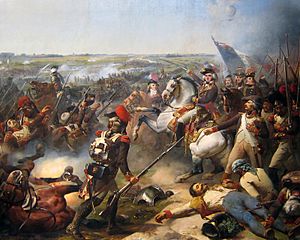
The new French Republic won more victories in Belgium and the Rhineland in late 1792. French armies defeated the Austrians and took over most of the Austrian Netherlands. This led to conflict with Britain and the Dutch Republic. After the French king was executed in January 1793, these powers, along with Spain, joined the war against France. French forces faced defeats and were driven out of their new lands. But the allies failed to take advantage of France's problems. By autumn 1793, France had put down internal rebellions and stopped the allied advance.
French victories in summer 1794 broke the stalemate. They defeated the allied army at the Battle of Fleurus, forcing them out of the Austrian Netherlands. The French then pushed allies to the east bank of the Rhine. By early 1795, France had conquered the Dutch Republic itself. The old Dutch government was replaced by the Batavian Republic, a French-controlled state. These victories caused the alliance against France to collapse. Prussia and Spain made peace with France in 1795. Only Britain and Austria remained at war.
Colonial Uprisings
The French Revolution had a big impact on French colonies. The Haitian Revolution (in Saint Domingue) was a major example of slave uprisings in French colonies.
Napoleonic Wars
Napoleon Bonaparte was one of the world's most powerful soldiers and leaders. He led France to great victories over many European enemies. He came from humble beginnings but became an Emperor. He changed much of European diplomacy, politics, and law. He was forced to give up his power in 1814. His attempt to return in 1815 failed at the Battle of Waterloo. He died in exile, remembered as a hero by many French people and a villain by his enemies.
Napoleon was France's most successful general in the Revolutionary wars. He conquered large parts of Italy. In 1799, he took control of the weak French government. He became popular by restoring the Church, keeping taxes low, and winning battles. In 1804, he crowned himself Emperor.
In 1805, Napoleon planned to invade Britain. But a new British alliance with Russia and Austria forced him to focus on Europe. At the same time, the British destroyed the French fleet at the Battle of Trafalgar, ending any invasion plans. On December 2, 1805, Napoleon defeated a larger Austro-Russian army at Austerlitz. This forced Austria out of the alliance and ended the Holy Roman Empire.
In 1806, a new alliance formed against France. On October 14, Napoleon defeated the Prussians. He then marched through Germany and defeated the Russians in June 1807. The Treaties of Tilsit divided Europe between France and Russia.
On June 12, 1812, Napoleon invaded Russia with nearly 700,000 troops. After some victories, Napoleon occupied Moscow, but the Russians burned it. He was forced to retreat. His army suffered greatly from attacks, disease, and starvation. Only 20,000 of his men survived.
By 1813, things turned against Napoleon. He was defeated by a seven-nation army at the Battle of Leipzig in October 1813. He was forced to give up his throne after his enemies occupied Paris. He was exiled to the island of Elba. He returned to France on March 1, 1815, raised an army, but was finally defeated by British and Prussian forces at the Battle of Waterloo on June 18, 1815. The old Bourbon kings returned to power in France.
Impact of the French Revolution
The Revolutionary and Napoleonic wars (1793-1815) caused millions of deaths. Outside France, the Revolution had a huge impact. Its ideas spread widely. Napoleon helped spread modern ideas like meritocracy (getting jobs based on skill), equality before the law, property rights, religious tolerance, and modern education.
French armies in the late 1700s and early 1800s ended old feudal systems in much of Western Europe. They changed property laws, ended fees paid to lords, and removed old trade rules to help businesses. They made divorce legal, closed Jewish ghettos, and made Jews equal to everyone else. The Spanish Inquisition ended, as did the Holy Roman Empire. The power of church courts was greatly reduced.
In foreign affairs, the French Army was very successful until 1812. France conquered Belgium and made it part of France. It conquered the Netherlands and Switzerland, making them puppet states. It took control of German areas on the left bank of the Rhine River and set up puppet governments. It conquered most of Italy, setting up new republics with new laws. These new countries had to pay money to France and provide soldiers for Napoleon's wars. Their governments were modernized, and trade barriers were reduced.
Most of these new nations were abolished in 1814 and returned to their old rulers. But Italians gained from the French Revolution. They got good laws, a fairer tax system, a better economy, and more religious freedom. Old barriers were removed, and Italians started to feel like one nation.
In Switzerland, the French Revolution also had a lasting impact. It declared citizens equal before the law, made languages equal, and gave freedom of thought and faith. It created Swiss citizenship, separated government powers, and removed internal trade taxes. It also improved justice and education.
In France itself, the biggest impact was the principle of legal equality. The powerful Catholic Church became controlled by the government. Power became centered in Paris, with a strong government and an army made of all young men. French politics became permanently divided into "left" and "right" for supporters and opponents of the Revolution's ideas.
Historians debate whether Napoleon was a good ruler who built modern Europe or a power-hungry leader who caused more suffering than anyone before Hitler.
China
Impact of the West
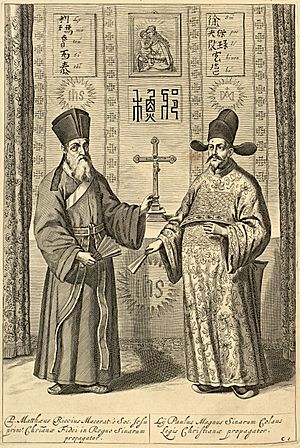
Ten Great Campaigns
The Manchu or Qing government in China used military force, diplomacy, and local leaders to expand its control into western regions. This was partly to counter Russian expansion. They launched Ten Great Campaigns in the mid-to-late 1700s. Three campaigns expanded Qing control in Central Asia. The other seven were more like police actions on existing borders.
The most important campaign was the destruction of the Dzungar people in 1755. This secured China's northern and western borders. The Ten Great Campaigns showed China's strength in its western areas, Mongolia, Tibet, and Turkestan. The main threat was Russia taking control, but treaties with Russia in 1689 and 1727 established stable borders. These treaties also allowed a Russian Orthodox mission in Beijing and some Russian trade. China's expansion to the west was its last major expansion.
India
Mughal Empire
The Mughal Empire (1526–1720) was founded by Babur. He used advanced weapons and cavalry to capture Delhi in 1526. Akbar (ruled 1556–1605) was a brilliant leader. He built a successful military and a financial system. The Mughal Empire had diplomatic ties with many local and international powers, including the French and English East India Companies. It allowed Europeans to set up trading forts because they brought trade and had strong navies.
The young Empire had problems. Huge spending drained its money and led to unpopular tax increases. The artistic achievements were impressive, like the Taj Mahal, built with expensive materials and jewels.
The ruling family often fought among themselves. Sons fought fathers, and brothers fought brothers for the throne. This led to distrust and weakened the government. By 1700, Europeans started controlling regional trade routes. They also began taking sides in local political fights. Even at its peak, the Mughal Empire was not fully centralized. Akbar gave his commanders rights to collect taxes locally instead of paying them salaries. This made these local leaders powerful and less dependent on the central government.
Aurangzeb (ruled 1658–1707) was very strict. He stopped spending on palaces and shrines. He ended the policy of religious tolerance and was seen as hostile by Hindus. They were not allowed to build temples, and a tax was put back on non-Muslims. Forced conversions to Islam started again. Hindus began to revolt. Most importantly, Aurangzeb spent decades fighting a costly war to capture the Deccan region in the south. It became harder to collect taxes from powerful local leaders who no longer felt loyal to the throne. This weakened the Mughal army. The Maratha Hindus, known for their military skills, took control of large areas by 1720. The Mughal emperor became a powerless figurehead. His empire was officially ended in 1857.
East India Company
The East India Company was a private British trading company. It exported British goods to India and imported Indian products like tea, spices, and textiles. It started with small trading posts and grew to control most of India by the 1850s. It used diplomacy and money, sometimes military force. By 1803, it had a large private army. The company eventually ruled large parts of India with its armies and took over government duties. British officers led Indian soldiers called "sepoys." Some Sepoys revolted in 1857. After heavy fighting, the British won. The British government then took over from the East India Company and set up the British Raj, which ruled most of India directly.
See also
- International relations (1814–1919)
- Great power
- List of modern great powers
- Timeline of European imperialism
- European balance of power
- International relations (1919–1939)
- History of Europe
- Foreign relations of imperial China
- History of French foreign relations
- Foreign policy of the Russian Empire
- Foreign relations of Spain
- History of the foreign relations of the United Kingdom


